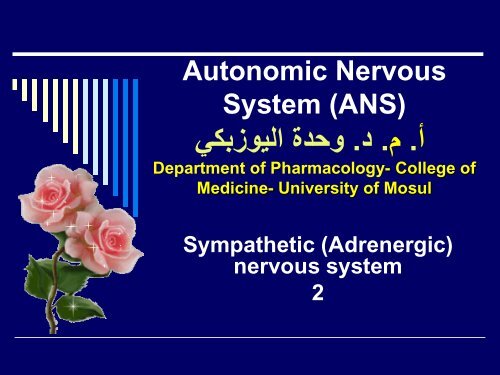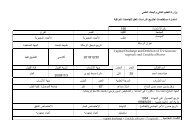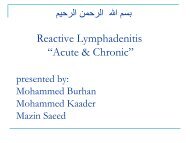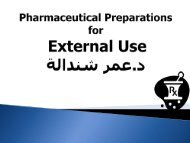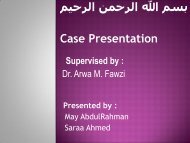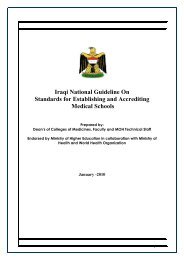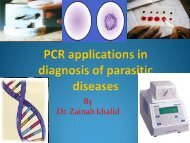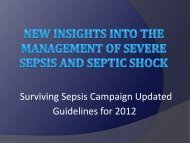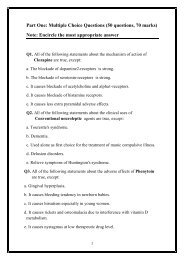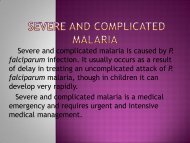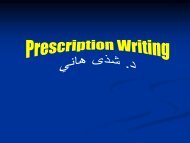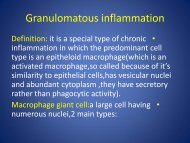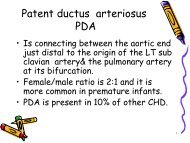Autonomic Nervous System (ANS)
Autonomic Nervous System (ANS)
Autonomic Nervous System (ANS)
Create successful ePaper yourself
Turn your PDF publications into a flip-book with our unique Google optimized e-Paper software.
<strong>Autonomic</strong> <strong>Nervous</strong><br />
<strong>System</strong> (ANS)<br />
د. م. أ.<br />
وحدة اليوزبكي<br />
Department of Pharmacology- College of<br />
Medicine- University of Mosul<br />
Sympathetic (Adrenergic)<br />
nervous system<br />
2
Objectives<br />
At end of this lecture, the students will be able<br />
to:<br />
1- Enumerate the classes of Adrenergic Agonists<br />
drugs.<br />
2- List the most widely used group (Direct acting<br />
adrenergic agonists).<br />
3- Discuss the most clinically used drugs in the direct<br />
acting adrenergic agonists.<br />
In a way, consistence with standards scientific<br />
curriculum.
Classifications of Adrenergic Agonists according to<br />
mechanism of action
Classifications of According to mechanism<br />
of action<br />
I- Direct acting adrenergic agonists:<br />
Adrenaline (A), Noradrenaline (NA),<br />
Isoproterenol (isoprenaline), Dopamine,<br />
Phenylephrine, Methaxamine, Salbutamol,<br />
Terbutalin, Clonidine, Xylometazoline,<br />
Fenoldopam.
II- Indirect acting adrenergic agonists:<br />
1- Amphetamine.<br />
2- Tyramine.<br />
III- Mixed-action adrenergic agonists.<br />
1- Ephedrine.<br />
2- Metaraminol.
I- Direct acting adrenergic agonists<br />
(Sympathomimitics)<br />
- These bind to<br />
adrenergic<br />
(postsynaptic)<br />
receptors & causes<br />
intracellular signals &<br />
initiate action.<br />
- As a group these<br />
agents are widely used<br />
clinically.
I- Direct acting adrenergic agonists<br />
1- Epinephrine (Adrenaline) A:<br />
- Natural catecholamine, commonly used in<br />
therapy.<br />
- In therapeutic low doses : β R effect<br />
- At high dose : α R effect<br />
Biotransformation:<br />
C.A metabolized by COMT and MAO, and result in<br />
production of metanephrine & vanillyl-mandelic<br />
acid (VMA) in urine.<br />
Note:<br />
A destroyed by acid of stomach & so not effective<br />
orally & usually given SC or IM injection.<br />
-
Action of Adrenaline<br />
1- C.V.S:<br />
- Adrenaline causes increase HR & contraction of<br />
heart which lead to increase CO and so to<br />
increase systolic Bdp.<br />
- But Adrenaline cause decrease PR , which<br />
lead to slight decrease D Bdp.<br />
(Adrenaline Lead to increase systolic Bdp<br />
& Slight decrease D Bdp).
C.V.S effect of Adrenaline<br />
(Epinephrine)<br />
Summary:<br />
(Adrenaline Lead to<br />
increase systolic<br />
Bd p & Slight decrease<br />
diastolic Bdp).
2- Respiratory:<br />
Bronchodilatation (β 2).<br />
3-Metabolic:<br />
a- hyperglycemia by increase<br />
glycogenolysis in liver (β 2) & increase<br />
release of glucagon (β 2) + decrease<br />
release of insulin (α2).<br />
b- Lipolysis: due to agonist effect on β R<br />
of adipose tissue.
Clinical uses of Adrenaline<br />
1- Acute asthma.<br />
2- Anaphylactic shock<br />
hypersensitivity reaction).<br />
(1 st type<br />
3- Anesthesia:<br />
a- With LA (dilution of A 1:10000 parts), as A<br />
lead to increase duration of LA by<br />
vasoconstriction at the site of injection.<br />
b- Topically (topical haemostatic agent).<br />
4- Glaucoma (2% topically) due to decrease<br />
production of aqueous humor by<br />
vasoconstriction of ciliary body blood<br />
vessels.
Side effects of Adrenaline<br />
1- C.N.S: anxiety, fear, tension, headache,<br />
tremor.<br />
2- Hemorrhage: (due to increase cerebral<br />
Bd p)<br />
3- Cardiac dysarrhythmia: (with digoxin).<br />
- Large dose lead to V.fibrillation (may be<br />
fatal).<br />
4- Pulmonary oedema.
5- Drug interaction with Adrenaline<br />
a- Hyperthyroidism:<br />
Adrenaline lead to hypertensive response due to<br />
increase adrenergic R on vasculature of the<br />
hyperthyroid patients.<br />
b- Cocaine:<br />
Cocaine lead to increase CV response of adrenaline<br />
due to ability to prevent reuptake of C.A into<br />
adrenergic neurons.
2- Nor epinephrine (NE) (Levarterenol,<br />
(Nor adrenaline)<br />
- It is the chemical mediator librated by<br />
postganglionic sympathetic N.ending & act<br />
directly on the effector cells.<br />
- In therapeutic doses: α R effect and similar<br />
β1R effect (on heart) but no β 2 R.
Action of Nor adrenaline (NA)<br />
C.V.S :<br />
NA increase PR due to intensive vasoconstriction<br />
of most vascular bed<br />
( including kidney via α 1R), which lead to increase<br />
both S & D Bdp<br />
(with increase mean Bdp). This lead to<br />
compensatory vagal reflex by stimulation to the<br />
baroreceptor reflex , which cause decrease<br />
contraction of heart & decrease HR ( called reflex<br />
bradycardia).
C.V.S effect of Nor adrenaline<br />
Summary:<br />
NA cause intensive<br />
vasoconstriction<br />
which lead to<br />
increase PR, and so<br />
to:<br />
increase both S & D<br />
Bd pressure, and this<br />
lead to:<br />
reflex bradycardia<br />
(Nor epinephrine)
Notes:<br />
1- Due to powerful vasoconstrictor effect of<br />
NA:<br />
a- Lead to reflex bradycardia. -<br />
b- NA not used as vasoconstrictor in LA<br />
solution.<br />
-<br />
2- The main function of NA appear to be<br />
maintenance of normal sympathetic tone<br />
and adjustment of circulatory dynamic.
3- Isoproterenol (Isoprenoline):<br />
- Direct acting synthetic C.A.<br />
- It is extremely potent β R agonist (β 1,<br />
β 2).<br />
PK: Given sublingually, pranterally & as aerosol.<br />
Uses: Usually to stimulate heart in<br />
emergency<br />
cases.<br />
SE: as Adrenaline.
Action of Isoproterenol (Isoprenoline)<br />
1- C.V.S: (Like A)<br />
Lead to increase systolic Bdp & Slight<br />
decrease D Bd p).--- ?<br />
2- Pulmonary:<br />
β2R:Rapid & profound bronchodilatation.<br />
3- Other effects:<br />
- β R: increase Bd sugar & increase lipolysis<br />
(not significant clinically).
4- Dopamine<br />
-It is immediate metabolic precursor of N.A<br />
occurs naturally in C.N.S in basal ganglia<br />
(function as N.T) and in adrenal medulla.<br />
-<br />
- Dopamine activates:<br />
1- β1 Receptors (and at higher dose<br />
activate also a R.),<br />
2- D1 & D2 R occur in peripheral mesenteric<br />
& renal vascular bed lead to vasodilatation.
Actions of Dopamine<br />
1- C.V.S: Dopamine lead to increase force &<br />
rate of contraction of heart (β1 effect).<br />
2- Renal and visceral: Dilatation of renal &<br />
splanchnic arterioles (D1,D2 agonist effect),<br />
which lead to increase blood flow to kidney &<br />
other viscera.<br />
Uses:<br />
Dopamine drug of choice (over A) in shock as A<br />
cause decrease renal blood supply & may<br />
cause renal shutdown.<br />
Overdose:<br />
Nausea, hypertension, arrhythmia.
5- Fenoldopam<br />
D1 Receptor agonist: selectively cause<br />
peripheral arteriolar vasodilatation in<br />
vascular bed.<br />
-<br />
Uses: in severe hypertension (IV or<br />
continuous infusion).<br />
SE:<br />
Decrease K, tachycardia, headache,<br />
flushing.<br />
-


